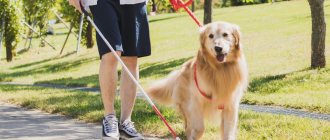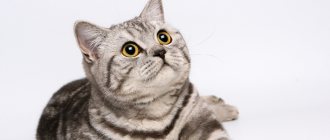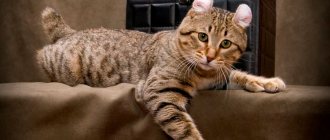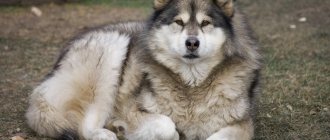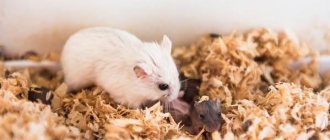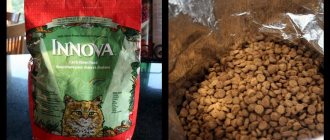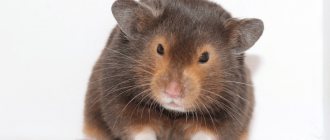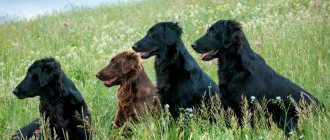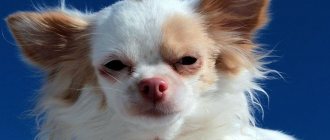Admit it, you can imagine a service, an old Chinese sage, a mountain, a dwarf coniferous tree, and whatever your heart desires when you hear the word “Chongqing,” but the dog is the last thing that comes to mind. Nevertheless, this is the name of representatives of one of the rarest breeds of animals on earth. Even in the historical homeland of these pets, in China, today you can find no more than a hundred representatives of this breed. Let's take a closer look at who Chongqing dogs are and why they are so rare and special.
Chongqing - a rare breed dog
About the breed
The bulldog appeared in China during the Han Dynasty in Sichuan Province, to which the city of Chongqing belonged. Animal statues and paintings on the walls were found in the family tomb.
Dogs guarded the emperor's palace. The appearance of the dogs inspired respect. Sensitive watchmen not only warned of danger, but also took measures to protect the territory. According to archival data, only noble Chinese could keep such bulldogs.
The Chongqing breed developed along the path of natural evolution, and not through selective breeding. This made it possible to consolidate the best qualities: courage, endurance, strength. Natural selection also affected the character of animals.
The population falls into the following categories:
- sentinels;
- hunting;
- official
Animals have an excellent sense of smell and hearing. The dogs of the elite Chongqing breed are not only good guards, but also hunters. They are especially good at catching small animals and birds. Only for a successful hunt will you need training.
Chongqing are good companions. They can provide significant assistance to people with disabilities, acting as guides.
During the beginning of the construction of communism in China, the bulldog was on the verge of extinction, since it was believed that only capitalists kept dogs.
At the end of the 20th century, the breed began to be restored. The situation worsened in 2003 during the epidemic. Now there are less than 2 thousand individuals left.
Fact: International cynological organizations do not recognize Chinese dogs of the Chongqing breed. The reason for this was the small spread of the eastern hound outside the country. Bulldogs do not have the opportunity to participate in exhibitions at the international level, since there are no FCI standards. Many breeders consider the situation unfair. The Chongqing Dog Conservation Center and other organizations are fighting this.
Origin story
Chinese chongqing dog (Chinese bulldog) is one of the most ancient breeds known to man in its unchanged form. The name is associated with the Chinese province of Chongqing.
Do you want to get a Chinese Bulldog?
Yes 82.35%
I think so far 8.82%
Has already! 8.82%
The ancient Chinese prized the Chongqing Bulldog, and it is one of the few varieties that has not been altered by mixing with other breeds for thousands of years. The ancient Chinese believed that even without any improvements this breed perfectly fulfills all its functions. But selection was carried out, albeit in the most primitive way - only the strongest individuals were left from the litter to be used as guards and hunters.
It is believed that the Chinese Chongqing dog was loved by emperors and their entourage. Strong animals are ideally suited to the favorite pastime of the nobility - hunting. Most commoners were not allowed to own a dog.
Too few individuals are distributed in other countries. At international exhibitions, due to the fact that the description of the breed is not defined by the FCI, the Chinese Chongqing cannot be found.
Appearance and disposition
Chongqing dogs, as in the photo, are medium in size. Males are more powerful than females. The weight of an adult is up to 25 kg, the height at the withers is up to 50 cm. The body weight of female representatives does not exceed 20 kg, and the height at the withers reaches up to 40 cm. According to the modern standard, three types of dogs are distinguished by height:
- standard;
- average;
- miniature.
The height of the standard Chongqing breed is from 45 to 55 cm, the medium - from 35 to 45 cm and the miniature - from 30 to 35 cm.
The body of dogs is muscular, strong, elastic. The head is large with a flat nose and upturned forehead. Well-defined cheekbones give her a square shape. The eyes are round and medium in size. Their color depends on the color of their coat. The jaws have a scissor bite.
There is a moderate amount of wrinkles on the muzzle.
The hard, erect ears with pointed tips are set high and have almost no hair. The tail is of medium length and cone-shaped. The main type of coat is short and harsh, ideally with a glossy sheen. Some representatives do not have it. The color of Chongqing dogs is brown, but sometimes even black. The most valuable color is the red-brown coat. A small white mark on the chest is acceptable.
Chinese bulldogs are wayward; rudeness, violence and insults are unacceptable for them. The use of punishment can provoke aggression. They are distrustful of strangers and animals. With proper systematic education, there is no risk of attack. The Chongqing dog is calm and balanced.
Dogs treat family members kindly, but prefer one owner. They enjoy playing at home with the children. Children should be taught how to handle the animal.
Character
It is difficult to unambiguously describe the nature of the breed, due to its low prevalence and the fact that some dogs are kept as hunting dogs, and some as guard dogs.
In general, they are very loyal and loyal dogs that form a close bond with their family. If a puppy is raised by one person, then only with him does he form a close bond. But, even if a puppy grows up in a large family, most often it chooses one owner and simply respects the others.
They are good-natured towards children, but are suspicious of children not from their family. In addition, they are dominant and should be owned by those who have experience managing such breeds.
Families prefer the company of strangers, whom they treat with caution. For the last two hundred years they have been kept as guards, so that mistrust is already quite ingrained in their character.
With proper upbringing and socialization, they are quite tolerant of strangers. But, training is very important, since by nature they have a strong protective instinct, are very territorial, sensitive and strong.
The Chinese Chongqing is an excellent guard who will protect the home and family until death. In addition, quite recently these dogs were used as hunting dogs, and in some places they are still hunted with them to this day.
They have a very, very strong hunting instinct and will chase any prey, from squirrels to bears. They are able to catch fish in the water, a bird in flight, and even on land... Some tolerate domestic cats if they grew up with them, but not all.
The Chinese Bulldog does not get along well with other dogs, especially males. When keeping it, it is better to choose an animal of the opposite sex; it is ideal to keep it alone.
There is no reliable data on the breed's trainability. Some say that the breed is highly intelligent and much more manageable than other Asian breeds. Others say that they are capricious and difficult.
Definitely, Chongqing would not be the best choice for beginning dog breeders, due to its dominance and strong-willed qualities. Most male dogs regularly challenge their owner's place in the pack hierarchy and prefer to do what they see fit.
Owners must put a lot of effort and experience into making their Chinese Bulldog obedient.
Their level of activity is average and an ordinary family is quite capable of meeting their needs. A daily walk and games for one hour completely satisfies them and will help them avoid such behavioral problems as aggression, destructiveness, and hyperactivity. At the same time, they are able to be much more active and easily adapt to the needs of the family.
They are known for rarely speaking. If they bark, it is to raise the alarm, while hunting, or to frighten a stranger, but they are usually quite quiet. This quality, coupled with moderate activity requirements, makes the breed a good option for city living.
Despite the fact that they feel most comfortable in a private home, they can live peacefully in an apartment.
The only inconvenience when living in the city is that they have a strong hunting instinct and dominance. Chongqing should be walked on a leash and in places where there are no other animals.
Proper care and maintenance
For a dog to develop properly, it needs proper care. The Chongqing or Chinese Bulldog is very active, so you need to walk him at least twice. During walks, he should be allowed to move as much as possible.
Advice: Do not expose your dog to frequent water procedures so as not to disturb the natural fat layer. Once every six months or less is enough.
When bathing, you should only use a special mild shampoo for dogs. It is necessary to take care of wrinkles on the skin, as dirt can accumulate in them.
Pets have their teeth brushed 2-3 times a month, which is especially important for young and older dogs. The veterinarian will remove tartar as needed. Approximately once a month, perform a shallow cleaning of the ears. There is no need to trim the claws; they grind down on their own. Contaminants from the eyes are removed with a small piece of cloth.
No brushing is required, the bulldog's coat is straight and hard, as in the photo. Simply wipe it with a damp cloth to keep your pet looking good. Usually the dog likes this procedure. Animals are vaccinated and dewormed as needed.
Distinctive features
This is a medium-sized dog, reminiscent of a smaller Molosser: the same folds on the muzzle, a rounded heavy body, large sad eyes. According to the standard, the external features of Chongqing must be as follows:
- The head is square, with a deep and long frontal furrow. The skull in the area between the ears is flattened, the cheekbones and brow ridges are highlighted. The stop is clearly pronounced.
- The muzzle is as wide as possible and should not narrow towards the tip of the nose. It is short, equal in length to half the skull. Visually it looks square; when viewed from the side, you will notice that the lines of the muzzle form a very obtuse angle. The bridge of the nose is straight. The jowled lips are moderately developed and fit rather tightly. Their color, like the shade of the mucous membrane in the mouth, should be bluish-black or spotted.
- The bite is “undershot”, with a deviation of no more than 5 mm. The jaws are powerful, square, the teeth are not visible if the mouth is closed.
- The nose is medium in size, not turned up, with large nostrils. The shade should only be black.
- The ears are set high, on the sides of the skull. Medium size, triangular with sharp ends, stand rigidly, cannot be docked.
- The eyes are oval, fairly large, moderately convex. The iris is brown or dark brown.
- The body is well-knit, muscular, slightly elongated (especially in females). The back is short, the topline is moderately inclined towards the withers. The loin is wide and convex. The belly is tucked in, the chest is deep and protruding. It is lowered to approximately the elbows. Its depth is equal to 1/2 of the height at the withers.
- The neck is moderately long and thick.
- The limbs are strong. The height to the elbow is equal to half the height at the withers. The pasterns are of short length, the angle of inclination is small. The elbows are not turned out, the forearms are powerful, rounded, vertically positioned relative to the body. The hind legs are muscular, the knee and hock joints are well formed. Paws are rounded.
- The tail is of moderate length, a continuation of the croup, tapering from base to tip. It is straight, round, raised high.
- The skin forms loose and thin folds in places. They are most pronounced on the forehead, especially in puppies, and also in the withers area. In this case, the folds should not be overdeveloped.
- The coat is short and lies tightly. Hard, coarse, single-layer, without undercoat. Sparse along the back, but present in the form of a strip about 3 cm wide along the spine, along the croup, hips and tail.
- Colors : black or red in various shades. A dark mask is required.
Training and education
Chongqing dogs need strict training, but without the use of physical force. It is best to maintain a partnership with your dog. The best option is to entrust the training to a professional dog handler.
The Eastern Hound needs regular and intense exercise. If it is not possible to work with the dog on a regular basis, then it is better to refuse to purchase it.
Representatives of this breed require socialization from an early age. They should be taught the right attitude towards other animals and strangers. Such dogs are kept in the yard, apartment, but not in an enclosure. But a country house with a high fence is best suited for this breed. You cannot put your pet on a chain. In winter, during frosts and cold weather, it is better for him to live in the house.
Theses
- This breed is very rare not only in Europe, but also in China itself.
- Until recently, these were exclusively hunting dogs.
- At home, they are divided into three types, according to size and structural features.
- They have a dominant and difficult character. Not recommended for beginners.
- They are very loyal and will protect their home and family to the end.
- They have virtually no hair on their ears and tail, and the tail has a unique shape.
- These dogs are of the same color - brown, variations can only be in its shades.
Health and life expectancy
Chongqing dogs are distinguished by good health, which was facilitated by the natural origin of the breed. On average, dogs live 18 years, and with proper care they can live longer.
Hereditary diseases are rarely transmitted in the population. However, external negative factors often cause skin problems. Dogs do not tolerate extreme heat or cold well. They can get burned in the sun.
Important advice: It is imperative to have your pets' vision checked. This is their weak point.
Psychological picture
The Chongqing is a calm and balanced breed that combines the characteristics of self-reliance and independence. However, this does not prevent dogs from maintaining boundless devotion to their owners. Animals have extraordinary mental abilities and understand their household members at a glance.
Key character traits:
- courage - pets are excellent watchdogs and are well suited for guarding a country house. Dogs show increased wariness towards strangers and will not allow “guests” into the territory without the owner’s permission;
- insight - animals amazingly determine the character of a person, can adapt to the disposition of the owner, show sociability and a willingness to compromise. Animals also sense the purpose for which strangers come into the house and can “warn” the owner about this with non-standard behavior;
- signs of aggression towards other dogs – the Chongqing is a cute and affectionate pet when around the family, but it can be aggressive towards other dogs. The choice of other pets in the house should be approached very carefully. The animals do not get along well with fighting dogs and do not like cats;
- caring for children - Chongqing is very tolerant of children’s games that are not always kind, and shows care and love. Babies can be left under the supervision of a smart dog;
- hunter's instincts - the breed has been hunting down prey for thousands of years, so when keeping chickens, rabbits, geese and other domestic animals, you should take care of their safety. Always close cages and pens, otherwise the dog's instincts may take over and cause damage to the household;
- leadership inclinations - elephant dogs make independent decisions, therefore, for successful training, the owner must have a strong and emotionally balanced character. Only then does Chongqing recognize a person as a leader. Therefore, getting a Chongqing dog as a first dog is not recommended. Developing the right character requires experience and an iron grip. Even an “experienced” owner may not be able to cope with the correct formation of the pet’s personality;
- energy – dogs love activity, do not sit idle, and are enthusiastic about playing with their owner.
Diet and feeding rules
A special balanced food has been developed for medium-sized purebred dogs. It should contain beef, poultry, and horse meat. Pork should not be given, as it causes intestinal obstruction. You can include by-products in your diet.
Healthy foods:
- Buckwheat and rice porridges
- Legumes
- Raw and baked vegetables
- Corn
Harmful products
- Milk and cottage cheese
- Flour products
- Butter (for porridge)
- Bread
Chongqing dogs should not be overfed, as this is dangerous to their health. Animals are prohibited from feeding raw meat, fish and bones. Puppies are fed up to 6 times a day, adding vitamins according to instructions.
DISEASES
The breed is susceptible to the following diseases:
- Does not tolerate heat and cold well;
- Food allergy;
- You can't sleep on hard things;
- Dislocation in the kneecap;
- Retinal atrophy (progressive);
- Acariasis or demodicosis from acne;
- Skin allergies;
- Skin infections;
- Flatulence;
- Sunburns;
- Problems with breathing;
- Brachycephalic syndrome.
Breeders' advice for buying a puppy
Since the breed is not widespread, purchasing puppies is not an easy task. Even in European countries and the USA, this is a very rare species of domestic animal.
In Russia there is a fan club and several owners of such dogs with experience in breeding. You can purchase a Chongqing puppy through him, or turn to foreign dog breeders for help.
The price depends on gender, age and other factors. On average, you should aim for 3-4 thousand dollars. On Avito, Chongqing breed puppies can be purchased at prices ranging from 120 to 450 thousand rubles.
Fact: Bulldogs from China are expensive dogs, so they are not very common.
When purchasing, it is recommended to contact a specialist; this will help avoid mistakes and deception.
Mating
You won’t be able to untie a dog of this breed on your own for one reason: it’s difficult to find a partner. Therefore, it is better to sterilize your pet at 7-12 months , before maturation begins.
If mating is still planned, you need to contact the breed club, where a dog handler will find a mate for the dog. Owners will fill out documents that will allow newborn babies to receive a pedigree. Also, the female and male will be tested for health and genetic diseases.
Bulldogs are bred on neutral territory or at the male’s home. The duration of the act is 30-40 minutes, 15 of which the animals must stand in the castle. The owners' task is to help the dogs sit comfortably and hold them if they fall.
You can track the progress of pregnancy after 2 weeks . It is important to monitor the girl’s health to exclude the development of inflammatory processes, false pregnancy or infectious diseases.
Read a detailed article on the topic: “Everything you need to know about breeding dogs: appropriate age, what to do if it doesn’t work out, rules and tips.”
Nurseries
There are no nurseries in Russia for breeding Chinese bulldog puppies. Animal lovers hope that measures will be taken to ensure that the population of the only Chinese bulldogs grows and there is no threat of extinction of the breed. These days these are hard to find animals. Buying a puppy requires a lot of effort, even at a high price.
Source
Was this article helpful?
Thank you for your opinion!
The article was useful. Please share the information with your friends.
Yes
No
X
Please write what is wrong and leave recommendations on the article
Cancel reply
Rate the benefit of the article: Rate the author
Discuss the article:
